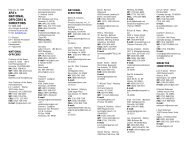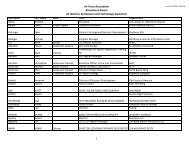The Air Force in the Vietnam War - Air Force Association
The Air Force in the Vietnam War - Air Force Association
The Air Force in the Vietnam War - Air Force Association
Create successful ePaper yourself
Turn your PDF publications into a flip-book with our unique Google optimized e-Paper software.
Heavy Bombers<br />
T<br />
he heavy hitter <strong>in</strong> <strong>the</strong> <strong>Air</strong> <strong>Force</strong><br />
l<strong>in</strong>eup was <strong>the</strong> B-52. It was <strong>in</strong> action<br />
from 1965 on, but political constra<strong>in</strong>ts<br />
from Wash<strong>in</strong>gton kept it from be<strong>in</strong>g<br />
used with full effect aga<strong>in</strong>st key targets<br />
<strong>in</strong> North <strong>Vietnam</strong> until 1972.<br />
Seventh <strong>Air</strong> <strong>Force</strong> <strong>in</strong> Saigon did not<br />
control <strong>the</strong> B-52s. <strong>The</strong>y were owned<br />
by Strategic <strong>Air</strong> Command, which reta<strong>in</strong>ed<br />
control. Bombers based on Guam<br />
flew <strong>the</strong> <strong>in</strong>itial “Arc Light” missions<br />
<strong>in</strong> South <strong>Vietnam</strong>. <strong>The</strong> <strong>Air</strong><br />
<strong>Force</strong> wanted <strong>the</strong> B-52s to<br />
be part of Operation Roll<strong>in</strong>g<br />
Thunder <strong>in</strong> North <strong>Vietnam</strong>,<br />
but was overruled by <strong>the</strong><br />
White House because of<br />
concern about “widen<strong>in</strong>g”<br />
<strong>the</strong> war. B-52s began<br />
operat<strong>in</strong>g from U-Tapao<br />
<strong>in</strong> Thailand <strong>in</strong> 1967, and<br />
from Kadena <strong>Air</strong> Base,<br />
Ok<strong>in</strong>awa, <strong>in</strong> 1968.<br />
<strong>The</strong> B-52 was an awesome weapon,<br />
work<strong>in</strong>g aga<strong>in</strong>st targets <strong>in</strong> South <strong>Vietnam</strong>,<br />
<strong>the</strong> Ho Chi M<strong>in</strong>h Trail, and<br />
around <strong>the</strong> Demilitarized Zone. It was<br />
particularly effective at Khe Sanh <strong>in</strong><br />
1968, where it destroyed tons of North<br />
<strong>Vietnam</strong>ese supplies and helped break<br />
<strong>the</strong> siege of <strong>the</strong> Mar<strong>in</strong>e outpost <strong>the</strong>re.<br />
Several models of B-52s saw service <strong>in</strong><br />
<strong>Vietnam</strong>. Notable among <strong>the</strong>m was <strong>the</strong><br />
B-52D, modified to carry a total of 108<br />
500-pound bombs—84 <strong>in</strong>ternally and 24<br />
on pylons under <strong>the</strong> w<strong>in</strong>gs.<br />
<strong>The</strong> biggest mission of <strong>the</strong> war for <strong>the</strong> B-<br />
52s was Operation L<strong>in</strong>ebacker II, Dec.<br />
18-29, 1972, when <strong>the</strong>y were unleashed<br />
on North <strong>Vietnam</strong>. <strong>The</strong>y flew 724 sorties,<br />
smashed <strong>the</strong> defenses of Hanoi and<br />
Haiphong, and brought North <strong>Vietnam</strong><br />
to peace negotiations.<br />
Not all of <strong>the</strong> MiGs were shot down<br />
by fighter pilots. On Dec. 18, 1972,<br />
dur<strong>in</strong>g Operation L<strong>in</strong>ebacker II, SSgt.<br />
Samuel O. Turner, tail gunner on a<br />
B-52D, downed a MiG-21 near Hanoi<br />
with .50 caliber mach<strong>in</strong>e gun fire. Six<br />
days later, A1C Albert E. Moore, also<br />
a B-52 gunner, shot down ano<strong>the</strong>r<br />
MiG-21 after a strike on <strong>the</strong> Thai<br />
Nguyen rail yard.<br />
49







